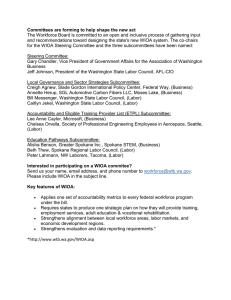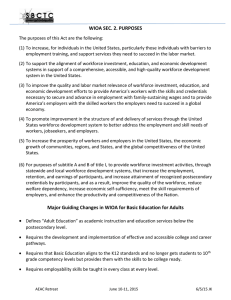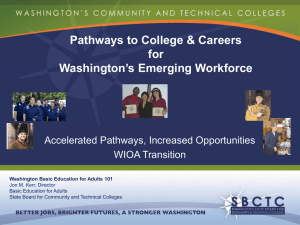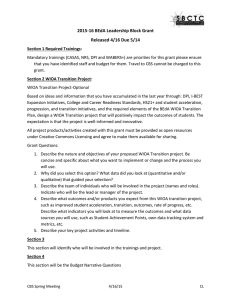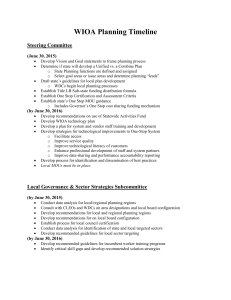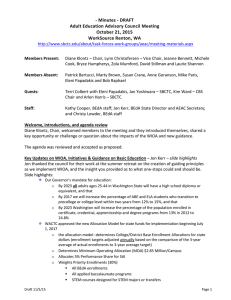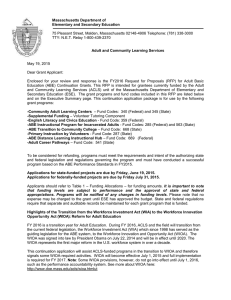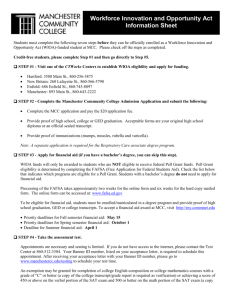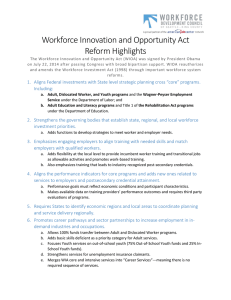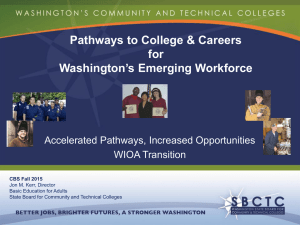- Minutes - Adult Education Advisory Council Meeting January 7, 2015
advertisement
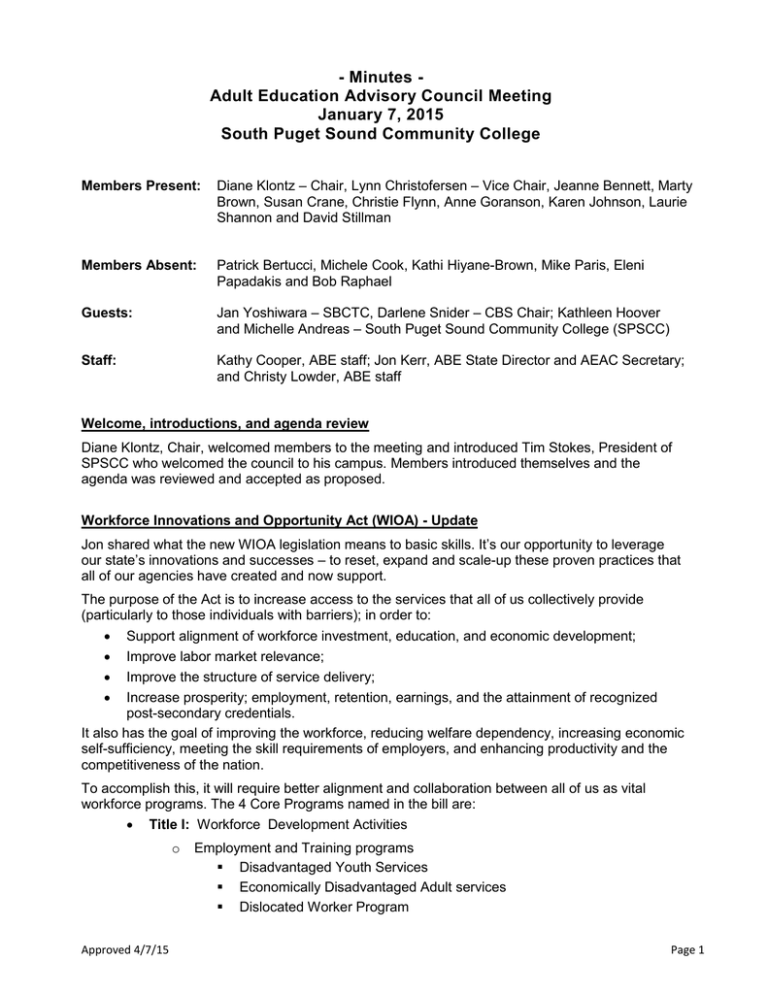
- Minutes Adult Education Advisory Council Meeting January 7, 2015 South Puget Sound Community College Members Present: Diane Klontz – Chair, Lynn Christofersen – Vice Chair, Jeanne Bennett, Marty Brown, Susan Crane, Christie Flynn, Anne Goranson, Karen Johnson, Laurie Shannon and David Stillman Members Absent: Patrick Bertucci, Michele Cook, Kathi Hiyane-Brown, Mike Paris, Eleni Papadakis and Bob Raphael Guests: Jan Yoshiwara – SBCTC, Darlene Snider – CBS Chair; Kathleen Hoover and Michelle Andreas – South Puget Sound Community College (SPSCC) Staff: Kathy Cooper, ABE staff; Jon Kerr, ABE State Director and AEAC Secretary; and Christy Lowder, ABE staff Welcome, introductions, and agenda review Diane Klontz, Chair, welcomed members to the meeting and introduced Tim Stokes, President of SPSCC who welcomed the council to his campus. Members introduced themselves and the agenda was reviewed and accepted as proposed. Workforce Innovations and Opportunity Act (WIOA) - Update Jon shared what the new WIOA legislation means to basic skills. It’s our opportunity to leverage our state’s innovations and successes – to reset, expand and scale-up these proven practices that all of our agencies have created and now support. The purpose of the Act is to increase access to the services that all of us collectively provide (particularly to those individuals with barriers); in order to: Support alignment of workforce investment, education, and economic development; Improve labor market relevance; Improve the structure of service delivery; Increase prosperity; employment, retention, earnings, and the attainment of recognized post-secondary credentials. It also has the goal of improving the workforce, reducing welfare dependency, increasing economic self-sufficiency, meeting the skill requirements of employers, and enhancing productivity and the competitiveness of the nation. To accomplish this, it will require better alignment and collaboration between all of us as vital workforce programs. The 4 Core Programs named in the bill are: Title I: Workforce Development Activities o Approved 4/7/15 Employment and Training programs Disadvantaged Youth Services Economically Disadvantaged Adult services Dislocated Worker Program Page 1 Title II: Basic Education for Adults Title III: Wagner-Peyser Employment Services Title IV: Vocational Rehabilitation Services We need to keep in mind the 3 key principles of WIOA: 1. Program Alignment: this involves unified strategic planning across all core programs. 2. Increased Accountability: establishes common performance measures across core programs 3. Enhanced Service Delivery: Requires the engagement of employers and alignment of education and training activities through the establishment of career pathways. The Workforce Training Education and Coordinating Board (WTECB) is the official state workforce development board under WIOA. They are setting up the structures for the 4 committees and have appointed co-chairs from Labor and Business for each committee. The law defines some critical changes in basic skills education that we support as integral to implementation of our current, new state basic education plan and the future Washington State Unified State Plan. The major guiding changes in the law for basic skills are: Requires the development and implementation of effective and accessible college and career pathways; Requires that Basic Education aligns to the K12 standards and no longer gets students to 10th grade competency levels but provides them with the skills to be college ready; Requires employability skills be taught in every class at every level; It supports—I-BEST-- or integrated, co-enrolled workforce and training programs that accelerate the transition to postsecondary certificates and degrees that ensure adults have the skills to secure family sustaining jobs and contribute to Washington’s 21st Century workforce; Includes math instruction and reading strategy instruction be taught at all levels for both ABE and ESL; New Clarification on EL Civics: The inclusion of integrated employment and training activities such as I-BEST is all that can be funded with Integrated English and Literacy Civics Education. EL Civics funds can now only be used for students in integrated, coenrolled employment activities (I-BEST). This may limit who applies for EL Civics funding; Includes speaking and listening for ABE; Expands the provision for technology using federal leadership funding; Supports One-stop centers. All core programs and a list of additional agencies will be required to support one-stop centers with in-kind support/services or funding (up to 1.5% of their total federal grant (ABE Master Grant and EL Civics grant); Increases accountability and demonstrated effectiveness in reaching federal targets; and But most importantly, it requires all of us to continue to expand collaboration work as an integrated team to advance the guiding principles that we believe in and have supported. WIOA provides us with new opportunities to form even deeper and more integrated partnerships with the next evolution of One-stops and our work-based initiatives. This intersects beautifully with all of our agencies work on navigational support to basic skills students. We have always shared customers, clients, and students. And the new WIOA requires us to identify how collaboration and the leveraging of resources will get all those we serve on career pathways to family sustaining jobs? And the law points to the one-stops as key to this collaboration. Approved 4/7/15 Page 2 So, how could/should One-Stops engage Basic Education for Adults providers and serve adults who need to increase skills in order to contribute to the workforce? WIOA – One-Stop Services Dual system that includes employers and potential employees – align with sector strategies Place Work Source staff at college (hoping for space without cost at college) – allow for co-enrollment and access to workers, employers see as higher skills. “students” not “clients” Re-invent Work Source – name; foot prints – old models in various settings – address coordination without costs – multiple access points – leverage online How does “system” get credit? Work experience Possibility of regional re-planning may shift AEAC Support for Legislative Action Marty Brown shared with the council the items that are on our radar for this legislative session: In the recession, basic skills programs were significantly reduced. We have put in a budget proposal that mirrors the K-12 funding system, funding enrollments in basic skills for adults as a caseload system – keeping the focus of the state investment on the students. We asked for $35 million and received $5 million Dedicated funding for I-BEST We asked for $15 million and received $5 million Increase funding for Student Achievement Initiative (SAI) Did not receive Increase funding for Opportunity Grants Did not receive Increase MESA program We asked for $4 million and received $2 million Council asked – what do you need from us? We’d like to have a letter of support from the AEAC and any individual letters of support either from your agency or as a private citizen where someone has needed and benefitted from our services. Kathy will create a draft letter and sent out to get council feedback ASAP. Navigation Initiative Kathy reminded group that they had all agreed to offer up some resource(s) to begin the implementation of navigation services in collaboration with a BEdA provider (CBO/college). Susan Crane shared an example of how SkillUp has used these tools for a navigator with one of their projects. Susan will share the tools used with the rest of the council, so that we are all working with the same tools for the council project moving forward. What can be done between now and the end of this year? An informal pilot between now and the Retreat in June… Edmonds and Everett Community Colleges and their WDC are working with youth at the Work Source in Everett and this would fit a project they are currently working on. Approved 4/7/15 Page 3 Walla Walla Community College is willing to work with Columbia Basin College to explore and work through the tool. OSPI has an Open Doors target to work with case management and needs a tool – thinks this will work beautifully (partner with 1418 project) – they currently have no common intake/assessment. SkillUp will donate all the materials (tools) that they have developed with Anne Laurie for their Life Domain project and they will work wonderfully for this pilot. Susan will also donate the database structure as well as the data from their project. Kathy will work with Susan Crane to set up training for all on the tool Business Meeting Approval of Meeting Minutes - Motion made to approve the Fall 2014 meeting minutes with a correction on page 2. The motion was seconded – minutes were unanimously approved as submitted with modification. Topics for the Spring meeting Life Domain update Plan & recommendations for retreat 101 type info session on the 4 Titles in WIOA, hear what they really do and what does that mean to you? Develop one-pagers for each Title WIOA update WTECB’s WIOA update (by Eleni or Terri) AEAC Calendar for 2014-15 Spring Meeting – on April 7th at Lake Washington Institute of Technology Retreat – June 9-11, 2015 at the Icicle Inn in Leavenworth Meeting was adjourned at 2:30 p.m. Parking Lot P3 project (grant), certain items can be waived and we need to keep track of outcomes based Approved 4/7/15 Page 4
